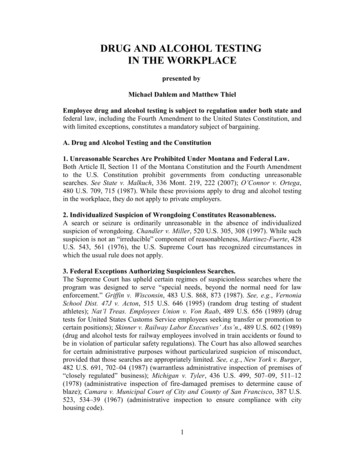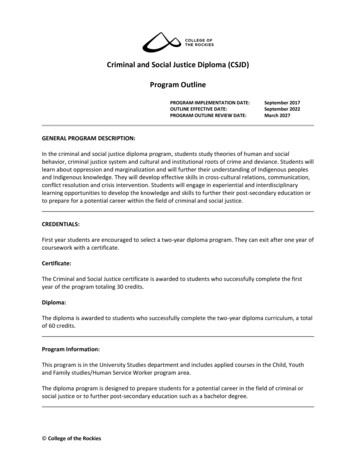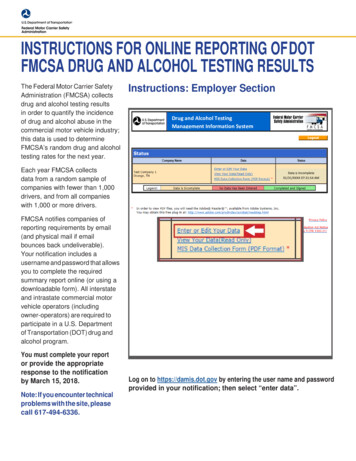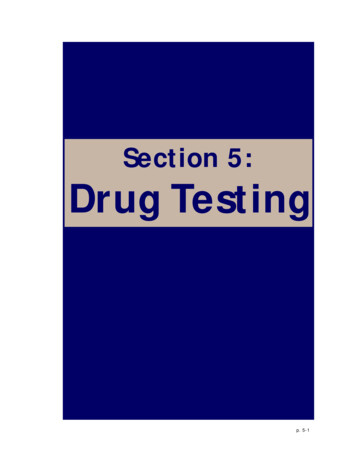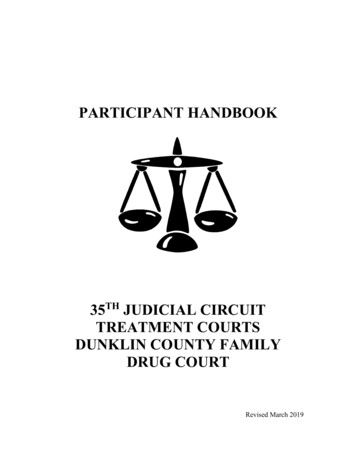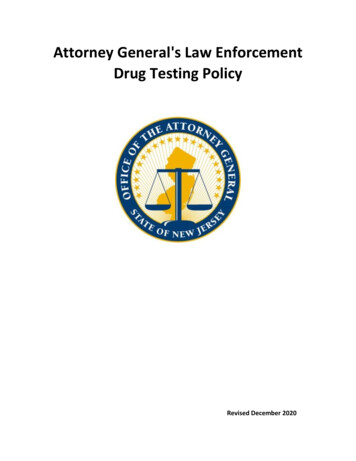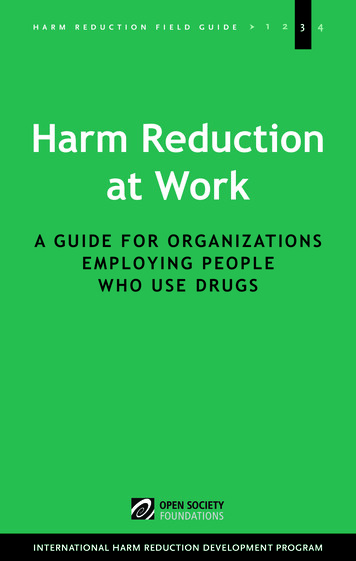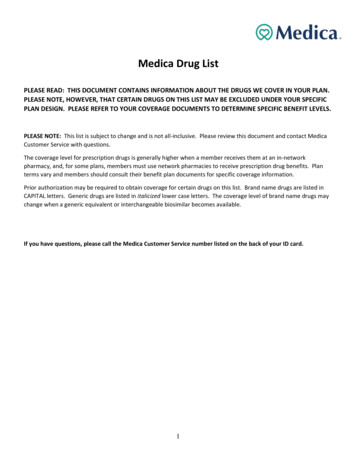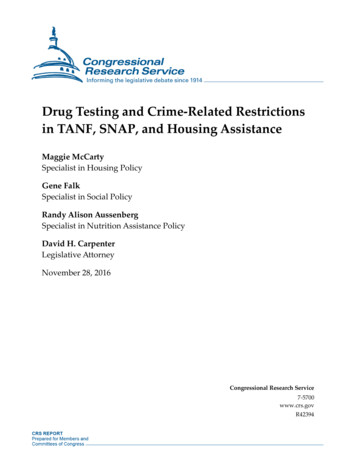
Transcription
Drug Testing and Crime-Related Restrictionsin TANF, SNAP, and Housing AssistanceMaggie McCartySpecialist in Housing PolicyGene FalkSpecialist in Social PolicyRandy Alison AussenbergSpecialist in Nutrition Assistance PolicyDavid H. CarpenterLegislative AttorneyNovember 28, 2016Congressional Research Service7-5700www.crs.govR42394
Drug Testing and Crime-Related Restrictions in TANF, SNAP, and Housing AssistanceSummaryThroughout the history of social assistance programs, administrators have attempted to limitaccess only to those families considered “worthy” of assistance. Policies about worthiness haveincluded both judgments about need—generally tied to income, demographic characteristics, orfamily circumstances—and judgments about moral character, often as evidenced by behavior.Past policies evaluating moral character based on family structure have been replaced by today’spolicies, which focus on criminal activity, particularly drug-related criminal activity. The existingcrime- and drug-related restrictions were established in the late 1980s through the mid-1990s,when crime rates, especially drug-related violent crime rates, were at peak levels. While crimerates have since declined, some remain interested in expanding these policies.The three programs examined in this report—the Temporary Assistance for Needy Families(TANF) block grant, the Supplemental Nutrition Assistance Program (SNAP, formerly FoodStamps), and federal housing assistance programs (public housing and Section 8 tenant andproject-based assistance)—are similar, in that they are administered at the state or local level.They are different in the forms of assistance they provide. TANF provides cash assistance andother supports to low-income parents and their children, with a specific focus on promoting work.SNAP provides food assistance to a broader set of poor households including families withchildren, elderly households, and persons with disabilities. The housing assistance programs offersubsidized rental housing to all types of poor families, like SNAP.All three programs feature some form of drug- and other crime-related restrictions and all threeleave discretion in applying those restrictions to state and local administrators. Both TANF andSNAP are subject to the statutory “drug felon ban,” which bars states from providing assistance topersons convicted of a drug-related felony, but also gives states the ability to opt-out of or modifythe ban, which most states have done. The 2014 farm bill also added new restrictions for certainex-offenders seeking SNAP assistance. Housing assistance programs are not subject to the drugfelon ban, but they are subject to a set of policies that allows local program administrators to denyor terminate assistance to persons involved in drug-related or other criminal activity. Housing lawalso includes mandatory restrictions related to specific crimes, including sex offenses andmethamphetamine production. All three programs also have specific restrictions related tofugitive felons.Recently, the issue of drug testing in federal assistance programs has risen in prominence. In thecase of TANF, states are permitted to drug-test recipients; however, state policies involvingsuspicionless drug testing of TANF applicants and recipients have been successfully challengedin courts. Most state policies on drug testing TANF applicants and recipients require the state tohave a “reasonable suspicion” that he or she is using illegal drugs. SNAP law does not explicitlyaddress drug testing, but given the way that SNAP and TANF law interact, state TANF drugtesting policies may affect SNAP participants. The laws governing housing assistance programsare silent on the topic of drug testing.The current set of crime- and drug-related restrictions in federal assistance programs is notconsistent across programs, meaning that similarly situated persons may have differentexperiences based on where they live and what assistance they are seeking. This variation may beconsidered important, in that it reflects a stated policy goal of local discretion. However, thevariation may also be considered problematic if it leads to confusion among eligible recipients asto what assistance they are eligible for or if the variation is seen as inequitable. Proposals tomodify these policies also highlight a tension that exists between the desire to use these policiesas a deterrent or punishment and the desire to support the neediest families, including those thathave ex-offenders in the household.Congressional Research Service
Drug Testing and Crime-Related Restrictions in TANF, SNAP, and Housing AssistanceContentsIntroduction . 1Evolution of Federal Policies . 1Overview of Selected Federal Assistance Programs . 4TANF . 4SNAP . 5Housing Assistance . 6Drug Testing and Crime-Related Restrictions . 7TANF. 7TANF Drug Testing. 7TANF Drug Felon Ban . 8Fleeing Felons and Other Crime-Related Restrictions in TANF . 10Applicability of Policies in TANF . 10SNAP . 10SNAP Drug Testing.11SNAP Drug Felon Ban .11“Fleeing Felon” Ban in SNAP . 13Applicability of Policies in SNAP . 14Housing Assistance . 17Drug Testing in Housing Assistance . 17Drug- and Other Crime-Related Restrictions in Housing Assistance Programs . 18Applicants . 19Recipients . 20Fleeing Felons. 22Applicability of Policies . 23“One Strike and You’re Out” and “No-Fault” Evictions . 23Legal Issues Involving Drug Testing Policies: Recent Developments . 23State Medical and Recreational Marijuana Laws . 24TANF . 25SNAP . 25Federal Housing Assistance . 25Conclusion . 26Similarities and Differences . 26Considerations for Policymakers . 27TablesTable 1. State Policies on TANF Drug Felony Disqualification for Applicants andRecipients . 9Table 2. State Policies on the SNAP Drug Felony Disqualification forApplicants and Reapplicants . 13Table 3. Summary of Federal Drug- and Other Crime-Related Restrictions in FederalHousing Assistance Programs . 22Congressional Research Service
Drug Testing and Crime-Related Restrictions in TANF, SNAP, and Housing AssistanceTable A-1. State Policies on Drug Testing for TANF Assistance Applicants and Recipients(As of October 2016). 29AppendixesAppendix. State Policies on Drug Testing in TANF . 29ContactsAuthor Contact Information . 37Acknowledgments . 37Congressional Research Service
Drug Testing and Crime-Related Restrictions in TANF, SNAP, and Housing AssistanceIntroductionThis report describes and compares the drug- and crime-related policy restrictions contained inselected federal programs that provide assistance to low-income individuals and families: theTemporary Assistance for Needy Families (TANF) block grant, the Supplemental NutritionAssistance Program (SNAP, formerly Food Stamps), and the three primary federal housingassistance programs (the public housing program, the Section 8 Housing Choice Voucherprogram, and the project-based Section 8 rental assistance program). These programs werechosen because they serve many of the same families. However, the programs also differ. Theyhave different drug- and other crime-related restrictions, with varying levels of federaladministration and discretion for state or local administrators.The drug- and crime-related restrictions in TANF, SNAP, and the housing assistance programswere developed at different times in different laws, but it appears they are intended to servesimilar purposes. To some extent, they are intended to deter people from engaging in drug-relatedand other criminal activity. They may also be intended to punish individuals for engaging inundesirable behavior. Further, when resources are limited, these policies may be intended todirect assistance to other households who are deemed more worthy of assistance. Additionally,particularly for housing assistance programs, drug- and crime-related restrictions may be intendedto protect vulnerable communities from the consequences of drug-related and other criminalactivity.The report begins by providing a brief overview of the history and evolution of policiesestablishing drug- and crime-related restrictions in federal assistance programs. It then brieflydescribes TANF, SNAP, and the three housing programs, and then discusses the specific policiesin those programs related to drug testing and drug-related and other criminal activity. It concludesby comparing and contrasting those policies and highlighting considerations for policymakers.Evolution of Federal PoliciesSince governments began providing assistance to the poor, policymakers have been concernedwith whether those receiving benefits were worthy of assistance.1 “Worthiness” has been definedboth by judgments of economic need—are families or individuals truly unable to meet their needswithout assistance?—and judgments of character, often as evidenced by certain behaviors. Whenthe federal cash assistance program began in the 1930s,2 states were permitted to consider the“moral character” of an applicant as a factor in determining eligibility.3 This led to states adoptingpolicies that reflected dominant societal expectations at the time about behavior and familystructure. Examples of such policies included so-called “suitable home” rules, giving state orlocal administrators wide discretion to disqualify applicants for assistance, and “man in thehouse” rules, penalizing unmarried mothers for cohabiting with men. These moral character1According to Regulating the Poor by Francis Fox Piven, as early as 1550 when relief for the poor began in Lyons,France, there were provisions to distinguish the “worthy” poor from the “unworthy” and assist only those deemed“worthy.” Frances Fox Piven and Richard A. Cloward, Regulating the Poor: The Functions of Public Welfare (NewYork: Pantheon Books, 1971).2The original program under the Social Security Act of 1935 was titled Aid to Dependent Children. It was renamedAid to Families with Dependent Children (AFDC) in 1962 and was replaced by the Temporary Assistance for NeedyFamilies (TANF) program in 1996.3Roger E. Kohn, “AFDC Eligibility Requirements Unrelated to Need: The Impact of King v. Smith,” University ofPennsylvania Law Review, Vol. 118, No. 8 (July 1970), pp. 1219-1250.Congressional Research Service1
Drug Testing and Crime-Related Restrictions in TANF, SNAP, and Housing Assistancepolicies were the subject of controversy and legal challenge; critics condemned such policies,arguing that, among other concerns, they had racial overtones and disproportionately affectedblack families, particularly black mothers.4 States that had adopted these policies argued that theydiscouraged immoral behavior.5 By the late 1960s and early 1970s, many of the policies related tofamily structure and behavior were struck down by federal administrative rulings and the courts.6Around the same time that morality tests based on family structure were being eliminated inAFDC, worries about rates of crime and drug use were increasing across the nation. Between1960 and 1980, violent crime rates more than tripled,7 and rates of drug use also increasedsignificantly.8 After first declaring a “War on Poverty,” the Johnson Administration formed theCommission on Law Enforcement and Administration of Justice and declared a “War on Crime.”9Several years later, the Nixon Administration declared drug abuse “public enemy number one inthe United States.”10 The federal “War on Drugs” was intensified by the Reagan Administration,particularly in response to the “epidemic” of crack-cocaine and its associated violence. Duringthis period, policymakers grappled with how best to address concerns about crime and drug use,their causes, and their disproportionate effects in poor communities, particularly predominantlyAfrican American urban communities.11 Policymakers also struggled with the challenge of how todistinguish between drug use as a crime and drug addiction as a public health problem.Specific drug-related sanctions were added to certain federal assistance programs for the firsttime by the Anti-Drug Abuse Act of 1988 (P.L. 100-690). The act made it the policy of the U.S.government to create a drug-free America and included both penalties for drug offenders as wellas support for drug abuse education and prevention. So-called “user accountability” provisionsdenied certain federal benefits—namely all grants, loans (including student loans), licenses, andcontracts—to persons convicted of certain drug-related crimes. Social Security, welfare programs(including AFDC [now TANF], Food Stamps [since renamed SNAP],12 and housing assistance),and veterans’ benefits were all exempted from these user accountability provisions in the finallaw, although earlier versions of the provision had included housing assistance and veterans’benefits in the definition of federal benefits.13 During debate on these user accountability4The concern about such policies being used to disguise systematic racial discrimination can be found in King v.Smith, 392 U.S. 309, 321-322 (1968).5Roger E. Kohn, “AFDC Eligibility Requirements Unrelated to Need: The Impact of King v. Smith,” University ofPennsylvania Law Review, Vol. 118, No. 8 (July 1970), p. 1226.6For example, suitable home provisions were restricted in 1960 by the so-called “Flemming Rule,” and in King v.Smith, 392 U.S. 309 (1968), the Supreme Court struck down Alabama’s substitute father regulation.7Department of Justice, Bureau of Justice Statistics, Uniform Crime Reporting Statistics, Violent Crime Rates, 19602009.8Robert Wood Johnson Foundation, Substance Abuse: The Nation’s Number One Health Problem, Key Indicators forPolicy, Update, February 2001, p. 15.9President Lyndon B. Johnson’s Annual Message to the Congress on the State of the Union, January 17, 1968,available at speeches.hom/680117.asp.10Richard M. Nixon, Remarks About an Intensified Program for Drug Abuse Prevention and Control, June 17, 1971,available at http://www.presidency.ucsb.edu/ws/index.php?pid 3047#axzz1kxlMtfYk.11Roland G. Fryer, “Measuring the Impact of Crack Cocaine,” National Bureau of Economic Research, Cambridge,MA, 2005, available at http://papers.nber.org/papers/w11318.12P.L. 110-246 renamed the Food Stamp program the Supplemental Nutrition Assistance Program, beginningOctober 1, 2008.13While housing assistance programs and veterans’ benefits were ultimately excluded from the definition of federalbenefit, they were included in the House version of the Anti-Drug Abuse Act, H.R. 5210, 100th Congress. The Senateversion of the bill included public housing among the exempted programs. For a discussion, see Christopher D.Sullivan, “‘User-Accountability’ Provisions in the Anti-Drug Abuse Act of 1988: Assaulting Civil Liberties in the War(continued.)Congressional Research Service2
Drug Testing and Crime-Related Restrictions in TANF, SNAP, and Housing Assistanceprovisions, supporters argued that they would serve as a deterrent to drug use,14 while detractorscriticized these provisions as “post-conviction penalties” to further punish drug offenders.15The act included congressional findings expressing specific concern about the role drugs anddrug-related crimes were playing in public housing communities. While the act excluded housingassistance programs from the federal user accountability bans, it did include provisions permittinglocal administrators to adopt policies restricting persons involved with drugs or drug-relatedcriminal activity from receiving federal public housing assistance and allowing for drug-relatedand other criminal activity to serve as grounds for termination of tenancy.Less than a decade later, Congress passed and President Clinton signed the PersonalResponsibility and Work Opportunity Reconciliation Act of 1996 (PRWORA; P.L. 104-193).PRWORA ended almost four decades of debate about how to reform the nation’s cash welfareprogram. During the welfare reform debates of the 1980s and 1990s leading up to PRWORA,welfare receipt was often mentioned together with crime and drug addiction as problemsafflicting the urban “underclass.”16While the focus of PRWORA was to fundamentally restructure cash assistance to make it timelimited and work-conditioned, it also included provisions to address the associated social ills ofcrime and drugs. The law made persons convicted of drug felonies subject to a lifetime ban onreceiving assistance under both the newly created TANF program as well as the federal FoodStamp program (now SNAP).17 This provision was added during Senate floor consideration of thebill and was the subject of only limited debate, with four Senators speaking briefly on the topic.The sponsor, Senator Phil Gramm, argued “if we are serious about our drug laws, we ought notgive people welfare benefits who are violating the Nation’s drug laws.” Opponents raisedconcerns about the implications for people who are addicted and their children.18 The act alsoauthorized states to drug-test TANF recipients and to sanction recipients who test positive fordrug use. It also added prohibitions on assisting “fleeing felons” to all federal assistanceprograms, including TANF, SNAP, and housing assistance.19Just prior to PRWORA, Congress passed a housing law (P.L. 104-120) that significantlyexpanded crime- and drug-related restrictions in assisted housing programs. The primary focus ofthe law was to extend the expiring authorizations for a number of housing programs, but it alsoincluded a section related to the “safety and security of public and assisted housing.” Specifically,the section made people who had been evicted from assisted housing for drug-related activitiesineligible for assistance for three years and permitted local administrators to restrict assistance tofamilies based on demonstrated patterns of drug use or alcohol abuse. This law was enacted(.continued)on Drugs,” 40 Hastings L.J. 1223 (1989).14Representative McCollum, Congressional Record, vol. 134 (September 8, 1988), p. H23000.15Representative Cardin, Congressional Record, vol. 134 (September 8, 1988), p. H23002.16For example, journalist Ken Auletta opens his 1982 book The Underclass with the question: “who are the peoplebehind the bulging crime, welfare, and drug statistics—and the all-too-visible rise in anti-social behavior that afflictsmost American cities?” Ken Auletta, The Underclass (New York: Random House, 1982).17See footnote 12.18Congressional Record, daily edition, vol. 142 (July 23, 1996), p. S8498.19The fleeing felon restrictions were incorporated from stand-alone legislation, S. 599 (104th Congress). During hisintroductory remarks, the sponsor of the legislation, Senator Santorum (PA), cited a need for information sharing withlaw enforcement and cited several instances of specific persons who had been receiving public assistance while theywere fugitives. Congressional Record, vol. 53 (March 22, 1995), p. S4383.Congressional Research Service3
Drug Testing and Crime-Related Restrictions in TANF, SNAP, and Housing Assistancefollowing President Clinton’s 1996 State of the Union address in which he claimed that the nationfaced a great challenge to take its streets back from crime, drugs, and gangs.20 In reference toassisted housing, he stated that “criminal gang members and drug dealers are destroying the livesof decent tenants.”21Just two years after enactment of PRWORA and P.L. 104-120, Congress passed the QualityHousing and Work Opportunity Reconciliation Act of 1998 (QHWRA; P.L. 105-276), a majorassisted housing reform law. The law modified and expanded the crime- and drug-relatedprovisions previously enacted in 1988 and 1996. QHWRA also included several provisions torestrict access to housing assistance for persons involved with several specific crimes, namely,production of methamphetamines and sex offenses. In the case of the methamphetaminerestriction, the provision was added during floor debate in the Senate, and the discussion of theamendment by its sponsors recounted the dangers associated with exploding methamphetamineproduction labs, citing several anecdotes related to such labs in assisted housing.22 Theamendment related to sex offenders was also offered as a House floor amendment.23 The sponsorspoke of a specific anecdote in which a child living in public housing had been assaulted by aperson previously convicted of a sex offense, as well as the dangers sex offenders may pose tocommunities more generally.24Overview of Selected Federal Assistance ProgramsThe following section of the report briefly describes TANF, SNAP, and major housing assistanceprograms. The next section of the report specifically discusses the drug- and crime-relatedprovisions of these programs.TANFThe Temporary Assistance for Needy Families (TANF) block grant provides grants to states,Indian tribes, and territories for a wide range of benefits, services, and activities that addresseconomic disadvantage. TANF is best known for funding basic assistance, state welfare programsfor low-income families with children. However, in FY2015, basic assistance represented only25% of TANF funds. TANF funds a wide range of activities that seek both to ameliorate theeffects of and address the root causes of child poverty. In addition to state block grants, TANFincludes competitive grants to fund healthy marriage and responsible fatherhood initiatives.The TANF cash assistance program provides aid to very poor families with children. Many ofthese families are headed by a single mother, though TANF also provides aid to families ofchildren cared for by non-parent relatives (e.g., grandparents, aunts, and uncles). States determinethe rules that govern financial eligibility for TANF cash assistance. States also determine the rulesfor how much a family receives in assistance (there is no federal eligibility floor). In July 2015,the maximum benefit for a family of three was 923 per month in Alaska, or 44% of povertylevel income. New York had the highest benefits in the lower 48 contiguous states and the Districtof Columbia, paying 789 per month (47% of poverty guidelines). Mississippi, the state with the20Statement of President William Jefferson Clinton, State of the Union Address, U.S. Capitol, January 23, 1996.Ibid.22Senate debate, Congressional Record, daily edition, vol. 144 (July 16, 1998), pp. S8366-S8367.23The amendment was added during floor debate of H.R. 2 (105th Congress), which was incorporated into P.L. 105276. Congressional Record, daily edition, vol. 143 (May 6, 1997), p. H2191.24Ibid.21Congressional Research Service4
Drug Testing and Crime-Related Restrictions in TANF, SNAP, and Housing Assistancelowest benefit levels, paid a family of three a maximum of 170 per month, 10% of povertyguidelines. The maximum benefit is generally the amount paid for a family with no other incomewho is complying with program requirements. Federal law limits cash assistance to a family withan adult to 60 months (five years of benefits). Additionally, states are subject to workparticipation standards and are required to have a specified percentage of their cash assistancefamilies engaged in work or job preparation activities. In June 2016, TANF cash assistance wasreceived by 1.5 million families, which had 1.0 million recipient adults and 2.7 millionrecipient children.Almost all federal policy for TANF relates to its cash assistance programs. However, TANF alsofunds a wide range of other benefits and services, including help to the working poor (child care,refundable tax credits), subsidized jobs, pre-kindergarten early childhood education, and benefitsand services for families at risk of having their children removed from the home because of abuseand neglect. States have considerable discretion in designing these programs, which are notsubject to time limits, work requirements, or the drug testing and crime-related restrictionsdiscussed in this report. There are no caseload figures to describe the number of familiesreceiving TANF benefits other than cash assistance.The TANF block grant is administered at the federal level by the Department of Health andHuman Services (HHS). State or local welfare offices administer the cash assistance fundedthrough TANF. TANF benefits or services other than cash assistance are administered by a rangeof state and local governmental entities as well as local (governmental, nonprofit, or for-profit)service providers. The federal government appropriated 17.3 billion for the block grant inFY2016, and states were required to contribute, in total, at least another 10.4 billion that yeartoward TANF or TANF-related programs.SNAPSNAP (formerly Food Stamps) provides benefits (through the use of electronic benefit transfercards) that supplement low-income recipients’ food purchasing power. Benefits vary byhousehold size, income, and expenses (like shelter and medical costs) and averagedapproximately 127 per person per month for FY2015. All 50 states, the District of Columbia,Guam, and the Virgin Islands participate in SNAP.25 In FY2015, SNAP had average monthlyparticipation of approximately 45.8 million individuals in 22.5 million households.In general, eligible households must meet a gross income test (monthly cash income below 130%of the federal poverty guidelines), a net income test (monthly cash income subtracting SNAPdeductible expenses at or below 100% of the federal poverty guidelines), and have liquid assetsunder 2,000. However, households with elderly or disabled members do not have to meet thegross income test and may have greater assets (under 3,250).26 Recipients of TANF cashassistance, Supplemental Security Income (SSI), or state-funded General Assistance arecategorically eligible for SNAP. The state option of broad-based categorical eligibility also allowsfor the modification of some SNAP eligibility rules and has resulted in the vast majority of states25In lieu of SNAP benefits, (1) Puerto Rico operates a nutrition assistance block grant program using rules very similarto the SNAP; (2) over 250 Indian reservations operate a food distribution progra
in courts. Most state policies on drug testing TANF applicants and recipients require the state to have a "reasonable suspicion" that he or she is using illegal drugs. SNAP law does not explicitly address drug testing, but given the way that SNAP and TANF law interact, state TANF drug testing policies may affect SNAP participants.

